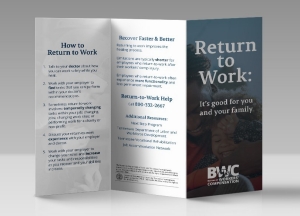Returning to Work
after a work-related injuryA successful return to work program relies heavily upon the attitudes and willingness of the injured worker and the employer. Workers have the most to gain from a quick, appropriate, and physician-guided return to work plan. The best plans are devised with input from:
- the injured worker
- the authorized treating physician
- the injured worker’s supervisor and/or return to work coordinator
- a nurse case manager
- the insurance claims adjuster; and
- an employee advocate such as a union or attorney, if applicable.
Stay in Touch
Injured workers are encouraged to actively communicate with the treating doctor, employer, and the claims adjuster about:
- History: The work you did before you were injured
- Current Condition: Your medical condition and the kinds of work you can do now
- Potential Options: The kinds of work your employer could make available to you or whether your job duties can be changed during your recovery
Start the Conversation
Employers, adjusters, case managers and other work comp professionals are encouraged to use this brochure start the return-to-work conversation with injured workers. It identifies the impacts that a work injury have on their health, career, and family. It includes a five-step process to getting back into the workplace.
Benefits to "Return to Work" Programs
The Tennessee Bureau of Workers’ Compensation encourages all employers to have injured workers return to work after a work injury. Quick, appropriate, and physician-guided returns to work have substantial benefits to injured workers, employers, and society.

Recovery
Research show injured workers who work light duty recover 30% faster, have a 7% reduction in medical expenses, and have better function upon the conclusion of their workers’ compensation claim.

Financial Health
Workers’ compensation disability benefits pay 66 and 2/3rds percent of an injured worker’s average weekly wage. The decline in income causes some workers to dip into savings or prioritize their spending.

Career
Returning to work helps injured workers retain seniority, longevity, maintain skills and training, and facilitates long-term career goals.

Co-Morbidities
Many studies show there are many health benefits to working including exercise and mental acuity. Other studies show declines in overall health to injured workers who are removed from the workplace that include: depression, diabetes, hypertension, and loss of mental sharpness.

Family
An important part of life is family. Work injuries can impact families. An injured worker’s inability to do chores, stress, and poor financial situation has negative consequences upon the entire family. Returning to work and returning to normalcy reduces a work injury’s impact on families.

Life
Expectancy
Life expectancy increases for those who return to work. Meaningful work increases one’s
general health and quality of life.

Control
WC Costs
Return to work programs are proven effective strategies to reduce temporary disability, permanent disability, and medical benefit payments to injured workers. As with any insurance, lower insurance rates are available for companies with lower workers’ compensation costs.

Tax
Incentives
The federal government offers three tax incentive programs to hire and retain persons with disabilities.
They include:
Small Business Tax Credit
Architectural /Transportation Tax Deduction
Work Opportunity Tax Credit
See www.IRS.gov for more information.

Intangibles
Many studies suggest effective return to work programs increase morale, improve productivity and quality, and improves customer service. Researchers suggest that a 0.2% increase in productivity can result in a return to work program paying for itself.

Turnover
Replacing, hiring, training new workers is an expensive process that can take considerable time. Studies indicate it takes 26 days, almost $3500, and 2 weeks of training to replace an injured worker.

Government
Programs
Injured workers who do not return to work are likely to pursue government benefits such as Temporary Assistance for Needy Families, SNAP (food stamps), and social security.

Charities
Charitable organizations often provide assistance to injured workers and their families while they are unable to work.

Funding
Non-working adults pay less in taxes.

Economic
Symbiotic Relationship
As seen during the COVID-19 pandemic, there is a
strong dependence between government financial health and businesses.
Scholarship for New Skills: A permanent impairment might prevent returning to work or getting back to full-time. Funds are available for qualified applicants to learn new job skills for a new career path.
Need More Help?
If you have additional questions, please call 615-532-4812 or 800-332-2667 or contact us by email at wc.info@tn.gov. Find out about other available assistance programs by contacting an ombudsman.
